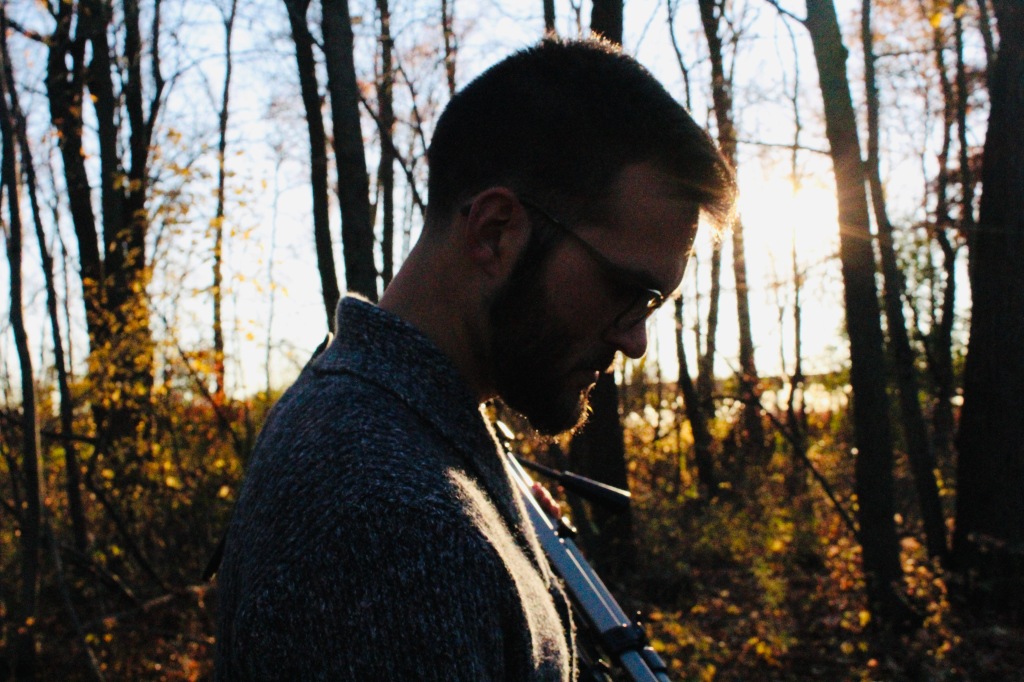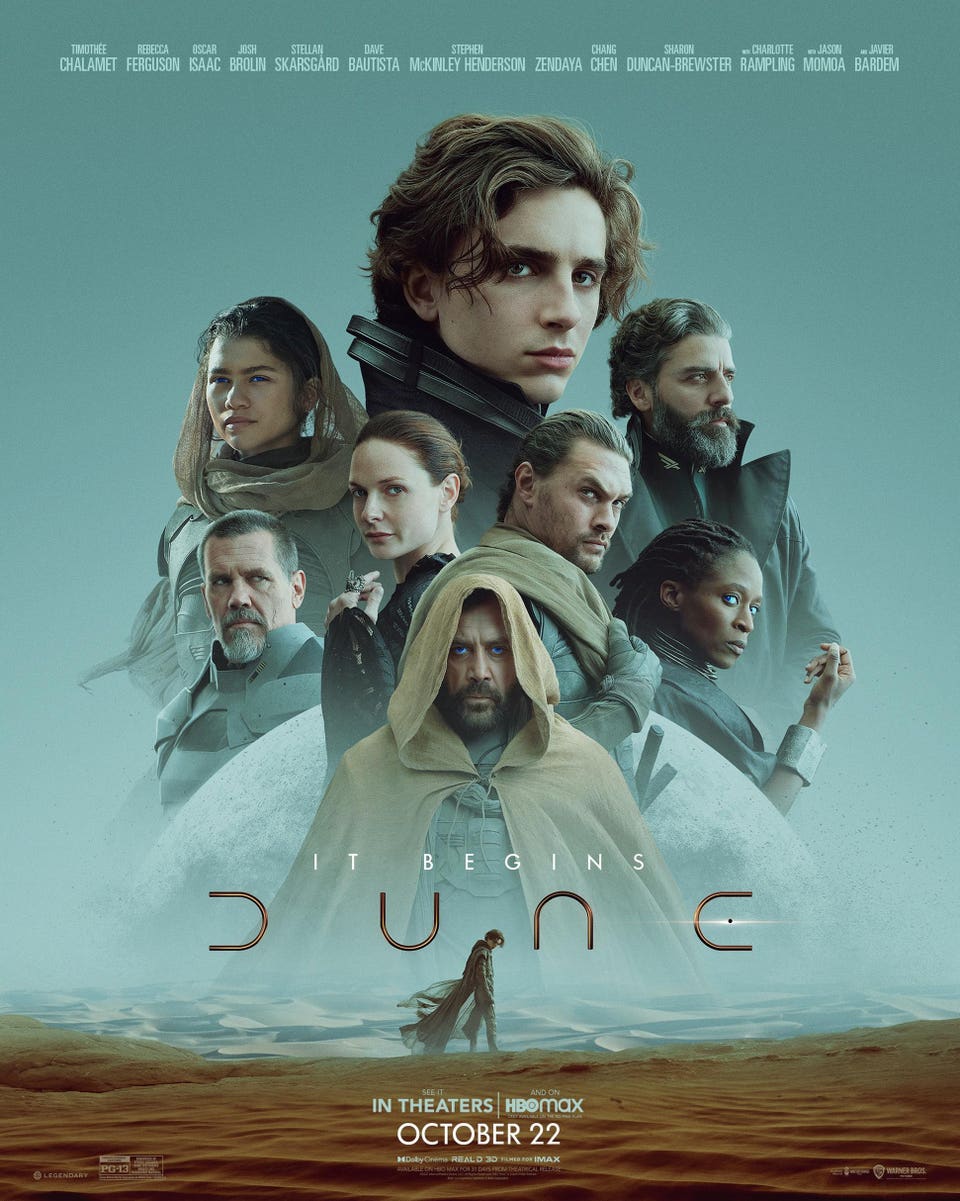Dune: Part 1 is a 2021 science-fiction film directed by Denis Villeneuve, based on the first half of Frank Herbert’s 1965 novel.
If you’re interested in my review of the book, click here! You should know that I haven’t read the whole Dune series, but only the first book. I only became interested in reading the book once I heard about this movie.
Why? I wouldn’t say I’m a Denis Villeneuve fanatic, but everything I’ve seen of him I’ve enjoyed at the very least, or love at the most. Sicario is one of my favorite movies ever. Arrival is one of my favorite sci-fi films. I enjoyed Blade Runner 2049, but I would be willing to listen to critiques of it. He juggles complicated characters while giving actors room to breathe, in the midst of selectively intense action scenes bolstered by breathtakingly real special affects.
This would seem like a perfect fit for Dune.
However, what worried me were my criticisms of Blade Runner 2049. That movie featured slow build-up worldbuilding and time-windy visions of the future, but it sometimes felt a little thin at the same time; like it spent so much time on making it feel epic rather than real substance. However, I would be willing to listen to corrections of my concerns.
In addition, all of the movies I’ve seen of Villeneuve had relatively small casts of characters. Sicario basically had 3 main characters, plus 2 or 3 that had one major scene each. Arrival basically had 3 main characters, with 2 or 3 lesser characters. Blade Runner 2049 also basically had 2; Harrison Ford didn’t show up until 2/3 of the way into the movie.
Dune is deliberately written to feature the viewpoints of no less than 15 characters, several of them easily qualifying as “major” characters, depending on the portion of the book you’re in. So, too, Dune is a heavily political movie, with multiple factions all competing for the world of Arrakis. None of his previous movies featured so many dynamics.
Would Villeneuve ensure that he would keep substance while juggling all the characters Dune had to offer? Would he be able to communicate the both the dynamics of the world as well as its major ideas concisely? Then, would he be able to shape this book into two coherent half-movies?
So far? I’m disappointed. But we’ll see what Part 2 holds.
The Good
As I expected, this movie is beautiful.
There were a couple shots of this movie that showed flaws with lighting or floaty animation, but besides those few examples, this movie is one of the most real movies I’ve ever experienced. The special effects contain ingenious practical elements – costume designs, vehicles, environments and landscapes, and more. The special effects also contain stunningly realistic CGI. While I was watching on my relatively small television screen, I usually have a pretty good eye for CGI. I can tell from lighting, weight, physics, and interaction with other on-screen elements whether something is computer-generated imagery. There were many scenes in Dune that were completely flawless. There was no transition between physical and computer-generated effect.
Not only were the effects good, they were also artful. It wasn’t just good technically; it was good art design. You could tell the Imperial from the Harkonnen from the Atreides from the Fremen. Every character faction had their own costumes, their own designs, their own looks. Caladan is clearly not Arrakis. Sardaukar are not Fremen. The artistry on display here is something else.
The Disappointing
You notice I put the “disappointing” pretty soon on here.
That’s because I was pretty disappointed with this one.
Now, Denis Villeneuve is not exactly known for his dialogue-heavy movies. Famously, Villeneuve and Benecio Del Toro cut most of Del Toro’s dialogue from Sicario. The performance earned Del Toro a BAFTA award nomination for Best Supporting Actor and is considered by many to be one of his finest performances. Villeneuve’s movies often feature intense visions of the future or surreal memories of the past that the characters must deduce. He flashes back and forth between timelines while leaving the audience and characters to figure out the mystery. And, Arrival messes with understanding time and features a form of precognition.
Ideas like these are all over Frank Herbert’s Dune (If you wanna see my feelings on the book and its themes, click here). Often, what characters don’t say is just as important as what they do say. While there is a lot of poetical dialogue (and just a lot of dialogue in general), there are also many moments where characters communicate through silence or through body language. In addition, spoiler alert, but halfway through the book the main character Paul begins experiencing time non-linearly, where he is able to decipher both the future and the past as a series of choices that connect endlessly back into each other, all while having strong visions. All of this sounds perfect for Villeneuve.
However, instead, the movie indulges Villeneuve’s worst tendencies. His movies have been called indulgent for their slow landscape shots, or long close-ups into people’s faces where their expression minutely changes. Take, for example, this four minute scene where K, the main character of Blade Runner 2049, explores the futuristic ruins of Las Vegas. Yes, you can pour over the symbolism; you can talk about the beehives and the gambling tables and the color of the shot. And it’s almost 2 hours into a three hour movie. Now, I love me some symbolism and time-taking. But it doesn’t feel like a lot gets accomplished for K or his character or the worldbuilding here that we didn’t know before. It’s beautiful, yes. But it’s inefficient.
This scene describes most of Dune.
A lot of the subtlety of the books has been removed. In taking the trickiness of Dune‘s stream-of-consciousness omniscient narrative style, Villeneuve instead settles for people just kind of stating their motives and bluntly stating what they’re going to do next. Duke Leto just says to Paul, “You know, at one time, I wanted to be a pilot.” Paul says, “Really?” And Leto says, “Yes.” And… there really isn’t much shared beyond that. We’ve had a statement. It hasn’t really added anything about our understanding of the characters and the world. It’s just blunt. It lacks subtlety. In addition, Dr. Yueh betrays the whole group; it’s a huge moment in the books because we’ve had chapters leading up to his betrayal. In the movie, he has like, two scenes. One with Paul where they share a secret message. One with Lady Jessica. That’s it. He needed more to make the betrayal hit; but it doesn’t. It’s just chess pieces moving.
He has all these grand landscape shots, of Paul walking across Caladan and seeing a spaceship taking off, of ‘thopters flying across Arrakis, of the desert in the distance. But… it’s just worldbuilding. And not necessarily saying more beyond “wooooow that looks REAL and COOL.”
Villeneuve sometimes also has a problem with structure. Blade Runner 2049 kind of just… ends. It’s a little lopsided in its form. Even Sicario has a climax that doesn’t involve its major character and ends with Emily Blunt crying in an apartment, broken and sad. It’s poignant, but it might feel a little anti-climatic. That’s the point, of course, but it could lean toward problems in structure with other kinds of stories.
Dune: Part 1 just kind of… ends. It just happens. There’s kind of some sort of duel. But it just… happens. It doesn’t culminate the themes of the story. In the book, really, it’s a duel that begins the tribal politics that dominate the second half of the book. But in the movie, it happens and the movie just kind of stops. You’d think with all that time on landscape shots and politics, we could have more on Paul not able to make the leadership decisions he needs to make. But not really. The visions all pretty much feature the same thing; Paul, with his future wife-to-be Chani, guiding him in the desert or in war. Several visions just lead to that. Not adding to character, not adding to information; just… happening. For the vibes, I suppose.
I think what’s emblematic of all of this is a scene that the movie cut from the books. Not that adaptions need to be the same as the source material. But this is emblematic of the disappointment.
The scene is a dinner party.
All of the major political characters from the first half of the book are in a single room. Stilgar, Liet-Kynes, Lady Jessica, Gurney Halleck, Dr. Yueh, Paul, Duke Leto. It’s an amazing scene of everyone maneuvering around each other, everyone trying to figure out their secret plans and who’s betraying who and how they’ll survive when the Harkonnens inevitably make their move. It’s full of intriguing conversation and chess-pieces moving. This scene is cut from the movie. This scene, which is full of silent character dynamics that Villeneuve should revel in as his favorite, cuts it so that the big slow explosions and fighting could happen.
Why?? Why THAT scene?? That should be THE scene in a movie all about politics! But instead, most of our major characters – Dr. Yueh, Liet-Kynes, Duncan Idaho, Gurney Halleck, Stilgar – get one scene with each with our main characters. There’s not convalescing of characters. The politics feel thin.
For a grand epic, it feels shallow and thin. You know two things or so about each characters, and then the character does something. That’s about it. It’s surprising how little you know about each character for a 3 hour movie. It’s crazy how repetitive it feels despite how much happens.
And Denis Villeneuve is amazing at breaking down complicated themes. Arrival and Sicario feature complicated themes of time, family, loss, grief, language, war, culture, drugs, international spy ops and shady legality, and trauma. Dune is about religion, war, prophecy, the end of the world, time, drugs, genetic manipulation, ecology, culture, how culture and climate interact, the messiah, and charismatic leaders. Villeneuve should take this in stride. But I don’t think people would tell you those are the themes of the movie if they hadn’t read the book. They’d say it’s a cool sci-fi world with amazing realistic technology and worldbuilding. But what’s the worldbuilding for? Landscape shots. Lots of landscape shots and repetitious visions.
I think what is emblematic of this is the scene where Duke Leto, Paul’s father, first meets Stilgar, chieftain of the tribal Fremen. There’s few words. Stilgar stares at Leto. Then, he spits on the ground. Everyone’s prepared to fight when local cultural expert Duncan Idaho stops them. He spits too. “We are honored by you giving your water for us.” And you think, “ahhh, water is important because they’re in the desert.” It’s played for soft comedy and a, “That’s cool!” But that’s it. It isn’t mentioned again and it doesn’t go deeper than that. Stilgar only appears once more in the movie. This could be a huge character moment that propels our understanding of the Fremen and Stilgar going forward and builds the world, but it’s more of a “Huh, that’s cool in a funny way!” The depth is left behind. The shell remains.
I don’t know how Dune: Part 2 is going to do in March. Maybe it’ll be ok.
Overall, this was a huge disappointment for me. It was beautiful. But it was surprisingly empty spectacle, especially for a director who is capable of more.

𝙷𝚒! 𝙼𝚢 𝚗𝚊𝚖𝚎 𝚒𝚜 𝙽𝚊𝚝𝚑𝚊𝚗. 𝙸’𝚖 𝚊 𝚐𝚛𝚊𝚍𝚞𝚊𝚝𝚎 𝚜𝚝𝚞𝚍𝚎𝚗𝚝 𝚠𝚑𝚘 𝚕𝚘𝚟𝚎𝚜 𝚜𝚝𝚘𝚛𝚢𝚝𝚎𝚕𝚕𝚒𝚗𝚐, 𝚕𝚎𝚊𝚛𝚗𝚒𝚗𝚐, 𝚊𝚗𝚍 𝚌𝚛𝚎𝚊𝚝𝚒𝚗𝚐, 𝚊𝚗𝚍 𝚊𝚕𝚜𝚘 𝚕𝚘𝚟𝚎𝚜 𝚝𝚘 𝚝𝚊𝚕𝚔 𝚊𝚋𝚘𝚞𝚝 𝚝𝚑𝚎𝚖 (𝚜𝚘𝚖𝚎 𝚠𝚘𝚞𝚕𝚍 𝚜𝚊𝚢 𝚝𝚘𝚘 𝚖𝚞𝚌𝚑!) 𝙵𝚘𝚕𝚕𝚘𝚠 𝚝𝚑𝚒𝚜 𝚋𝚕𝚘𝚐 𝚝𝚘 𝚜𝚎𝚎 𝚖𝚘𝚛𝚎 𝚌𝚘𝚗𝚝𝚎𝚗𝚝!


Leave a comment